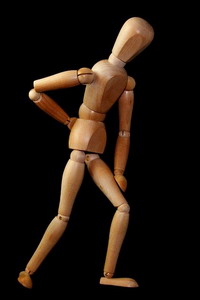
One of the thoughts every new patient has when they come for their first visit is “how long will it take to heal my injury so my pain will go away?” I know that is the first thing on my mind. This newsletter will try to answer that question.
First things first – pain means something is not right; something is injured. Pain is there to alert you to this injury and to keep you from making it worse. Several events in the body will trigger the pain response. The most common we see and the type I deal with most of the time is some sort of structural damage to tissues – usually muscular or ligament tissues. The second most common is hypoxia or lack of blood flow/ decreased oxygen. This type is very serious to the body and normal pain killers usually have little effect on hypoxic pain. Additionally, with decreased blood flow to the tissues, they are not getting a steady supply of nutrition they need to function or repair. The third type we commonly experience is chemical pain caused by the build-up of nasty chemicals and metabolic waste products in muscles or joints. A simple version of this is the soreness you get the day after a strenuous workout. The fourth type is inflammatory nerve pain like you get with shingles or a disc injury pressing on nerves in the spine. A fifth type to mention is psychogenic pain, which is caused by the pain processing centers in the brain misinterpreting signals from the body as pain or even inventing pain perceptions without any signals at all, such as in phantom limb pain.
So as you can see, your pain is not as simple as it feels. There could be many causes for the pain, and often several causes overlap. This is why I have to do an initial exam on everyone – to determine what is what and come up with a plan.

One thing that is almost universally present with pain is muscle tension. This tension squashes blood vessels and decreases oxygen, causing hypoxic pain. The tension is trying to limit movement to protect the painful area, but the tension may also be pulling on injured tissues causing direct pain. The longer the muscles are tight, the more the nasty chemicals and metabolic waste products build up in the tight muscles causing chemical pain. If the tension pulls joints down onto nerves, direct nerve pain can result. And then the pain generates fear which promotes an increase in psychogenic pain. So muscle tension is central to the whole pain response, and a key component I work to address.
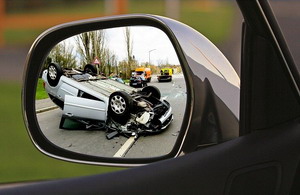
Most of the time I deal with one of two injury mechanisms – acute macro trauma (think getting hit by a bus) and repetitive microtrauma (think bad posture sitting at the computer). Both “injuries” produce similar consequences in the tissues. Muscle tension forms and the whole pain process begins. An additional negative consequence is that within four days of pain onset, tough fibrous connective tissue starts to form to hold the area tightly “in place” like a cast. The muscles can only stay tight for so long so the body forms a more permanent solution by gluing everything together. This is a good thing if your injury is a big gash in your muscle from falling off a cliff. That connective tissue forms a sling and stops blood loss. It is not so helpful when the injuries are just soft tissue spasm due to bad posture or simple muscle strain from poor lifting or overexertion. We call these tough glue adhesions, and it prevents the tissues from returning to normal. Part of the treatment of injured tissues is the breaking up of these adhesions so we can return blood flow to the area. The adhesions maintain squeezing pressure on the area which blocks proper blood flow and lymph drainage. Blood is needed to bring healing nutrition and repair cells and both blood and lymph are necessary to carry away dead and damaged tissue.

A couple of weeks ago I wrote an article about how I am not really moving bones around when I am doing a Chiropractic adjustment. I talked about using neurological techniques to rewire the communication between the brain and the muscles to reestablish muscle balance and proper tone. This is all about getting rid of muscle spasm/ tension so we can improve blood flow and relieve the different causes of pain. You may notice that often I will adjust a given area many times, or use my electronic adjusting tool that taps many times. Sometimes I even have to pull out the percussor to vibrate the tissues in and out. This is to break up the adhesions that are trying to keep everything where it is (in a state of tight contraction). Unfortunately, ‘where it is’ is not where it needs to be to heal.

If we were jellyfish in a big pool of water, just jiggling the tissues around to loosen things up would probably be enough to stimulate healing. But because we have to stand upright against gravity, we have to have a massive system of muscles and joints that all have to balance against each other perfectly to prevent undue muscle tension at any one spot. This is where the art and science of Chiropractic come in. Not only do the tight areas have to be loosened up, but the weight-bearing areas of the body that have had to compensate for the restricted areas also have to be normalized. As I have said to all of you “Everything affects everything else.” You have to work on the whole picture, not just the area of complaint.
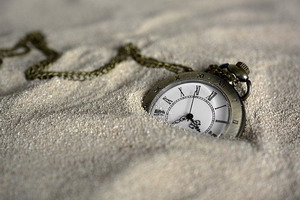
Okay, finally we get to address the original question – how long will it take to heal? We had to get some idea of what is going on behind the scenes for the answer to even make sense. The first obvious answer to the question of how long depends upon what is wrong in the first place. Unfortunately, the level of pain does not tell us what or how bad the injury is. Some incredibly painful conditions can clear up almost instantly when proper blood flow is reestablished. Other annoying nagging conditions caused by chronic poor muscle habits or old injuries can seem to last forever. In general, the longer a condition has been there allowing for more adhesion formation, the longer it takes to recover. When ruptures or massive tissue tears take place, healing time is controlled by the amount of blood supply to that tissue. For instance, muscles have a very good blood supply, and even large tears heal within two to four weeks. Tendons (which tie muscles to bones) and bones have less blood supply and can take 1 to 3 months to heal. Ligaments (which tie bones to other bones), cartilage, and discs have almost no blood supply so when they are injured significantly they rarely heal properly. These realities are why you don’t want to get into a car accident. These are acute trauma injuries usually. I have to tell folks that have been in auto accidents that healing from these type of injuries generally takes three to twelve months, and even then may leave permanent residuals.
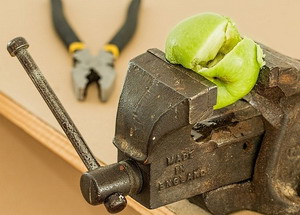
Fortunately for me (and patients), 95% of the pain conditions I see are from the repetitive microtrauma category. These generally involve muscle spasms, imbalance, and strain (micro tears). These may compress nerves in joint capsules or produce swelling that compresses major nerves down legs or arms, but usually, the issue is still muscular. To date, the majority of my patients recover within one to three visits. When a pain pattern lasts longer than this, it means either there is an underlying pathology like degenerative disc disease, degenerative joint disease, digestive pathology, a boatload of other doctor stuff, or the person is continuing to engage in activities that recreate the condition.
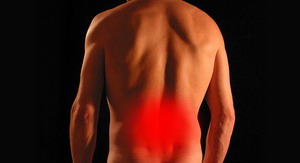
Right now we are seeing a rash of low back pain due to tight hip flexor muscles because people are sitting too much during this lockdown. When you sit for more than about 20 minutes, the hip flexors (psoas primarily) tighten up and stay tight when you try to get up. This pulls the low back forward as you arise, jamming the low back joints and causing pain. This is an example of repetitive microtrauma – every time you get up you traumatize your low back a little bit. If you got it corrected as soon as it happened it would be fine either immediately or within a day or two depending on if any internal bruising took place at the joint.
So how long does it take to recover? If you fall into the 95% of patients category that I see, typically recovery happens within a day to a week. When there is severe trauma or very chronic conditions, recovery can take months.
Take care,
David
